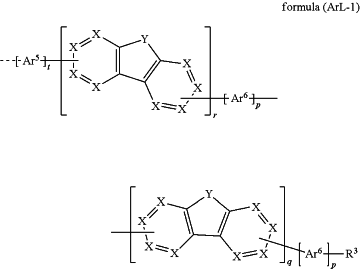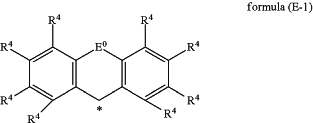| CPC C07D 495/04 (2013.01) [C07D 307/91 (2013.01); C07D 403/12 (2013.01); C07D 407/12 (2013.01); C07D 407/14 (2013.01); C07D 495/14 (2013.01); C07D 495/20 (2013.01); H10K 85/622 (2023.02); H10K 85/624 (2023.02); H10K 85/626 (2023.02); H10K 85/633 (2023.02); H10K 85/636 (2023.02); H10K 85/654 (2023.02); H10K 85/6574 (2023.02); H10K 50/12 (2023.02); H10K 2101/90 (2023.02)] | 16 Claims |
|
1. Compound of the formula (1),
 where the following applies to the symbols and indices used:
ArS is on each occurrence, identically or differently, an aromatic or heteroaromatic ring system having 5 to 40 aromatic ring atoms, which may in each case also be substituted by one or more radicals R1;
Ar1, Ar2, Ar3, Ar4 stand on each occurrence, identically or differently, for:
an aromatic or heteroaromatic ring system having 5 to 60 aromatic ring atoms, which may in each case be substituted by one or more radicals R1; or
a group ArL;
ArL stands on each occurrence, identically or differently, for a group of formula (ArL-1),
 where the dashed bond in formula (ArL-1) indicates the bonding to the structure of formula (1);
X stands for CR2 or X stands for C, if it is bonded to Ar5, Ar6, R3 or to an adjacent fluorene-type derivative unit;
Y stands on each occurrence, identically or differently, for —BR0—, —C(R0)2—, —C(R0)2—C(R0)2—, —C(R0)2—O—, —C(R0)2—S—, —R0C═CR0—, —R0C═N—, —Si(R0)2—, —Si(R0)2—Si(R0)2—, —C(═O)—, —C(═NR0)—, —C(═C(R0)2)—, —O—, —S—, —S(═O)—, —SO2—, —N(R0)—, —P(R0)— and —P((═O)R0—;
Ar5, Ar6 stand on each occurrence, identically or differently, for an aryl or heteroaryl group having 6 to 18 aromatic ring atoms, which may in each case be substituted by one or more radicals R3;
G is selected from the group consisting of formulae (G-1-1) to (G-1-23),
    where
the dashed bonds indicate the bonding to the adjacent groups as depicted in formula (1);
the groups of formulae (G-1-1) to (G-1-23) may be substituted by one or more radicals R4 or one or more groups ArL at any free positions;
E2 stands, on each occurrence, identically or differently, for —C(RE)2—, —O— or —S—;
Ar7 stands on each occurrence, identically or differently, for an aryl or heteroaryl group having 6 to 18 aromatic ring atoms, which may in each case be substituted by one or more radicals R4, wherein at least one of the group Ar7 in formulae (G-1) and (G-2) has 10 or more aromatic ring atoms;
Ar8 stands on each occurrence, identically or differently, for an aryl or heteroaryl group having 6 to 18 aromatic ring atoms, which may in each case be substituted by one or more radicals R4 or one or more groups ArL;
E is identically or differently on each occurrence, selected from —BRE—, —C(RE)2—, —C(RE)2—C(RE)2—, —C(RE)2—O—, —C(RE)2—S—, —REC═CRE—, —REC═N—, Si(RE)2, —Si(RE)2—Si(RE)2—, —C(═O)—, —C(═NRE)—, —C(═C(RE)2)—, —O—, —S—, —S(═O)—, —SO2—, —N(RE)—, —P(RE)— and —P((═O)RE)—; or E is a group of formula (E-1),
 where the symbol * in formula (E-1) indicates the corresponding group E in formula (G-1) or (G-2); and
where two groups E may be in a cis- or trans-position relative to each other;
E0 is identically or differently on each occurrence, selected from the group consisting of a single bond, —BR4—, —C(R4)2—, —C(R4)2—C(R4)2—, —C(R4)2—O—, —C(R4)2—S—, —R4C═CR4—, —R4C═N—, Si(R4)2, —Si(R4)2—Si(R4)2—, —C(═O)—, —C(═NR4)—, —C(═C(R4)2)—, —O—, —S—, —S(═O)—, —SO2—, —N(R4)—, —P(R4)— and —P((═O)R4)—;
RE stands on each occurrence, identically or differently, for:
H, D, F, Cl, Br, I, a straight-chain alkyl having 1 to 40 C atoms or branched or a cyclic alkyl group having 3 to 40 C atoms, each of which may be substituted by one or more radicals R5, where in each case one or more non-adjacent CH2 groups may be replaced by R5C═CR5, C≡C, Si(R5)2, Ge(R5)2, Sn(R5)2, C═O, C═S, C═Se, P(═O)(R5), SO, SO2, O, S or CONR5 and where one or more H atoms may be replaced by D, F, Cl, Br, I or CN, an aromatic or heteroaromatic ring systems having 5 to 60 aromatic ring atoms, which may in each case be substituted by one or more radicals R5, where two adjacent substituents RE may form a mono- or polycyclic, aliphatic ring system or aromatic ring system, which may be substituted by one or more radicals R5; or RE stands for a group ArL;
R0, R1, R2, R3, R4 stand on each occurrence, identically or differently, for:
a group selected from H, D, F, Cl, Br, I, CHO, CN, N(Ar)2, C(═O)Ar, P(═O)(Ar)2, S(═O)Ar, S(═O)2Ar, NO2, Si(R5)3, B(OR5)2, OSO2R5, a straight-chain alkyl, alkoxy or thioalkyl groups having 1 to 40 C atoms or branched or a cyclic alkyl, alkoxy or thioalkyl groups having 3 to 40 C atoms, each of which may be substituted by one or more radicals R5, where in each case one or more non-adjacent CH2 groups may be replaced by R5C═CR5, C≡C, Si(R5)2, Ge(R5)2, Sn(R5)2, CO═O, C═S, C═Se, P(═O)(R5), SO, SO2, O, S or CONR5 and where one or more H atoms may be replaced by D, F, Cl, Br, I, CN or NO2, an aromatic or heteroaromatic ring systems having 5 to 60 aromatic ring atoms, which may in each case be substituted by one or more radicals R5, or an aryloxy groups having 5 to 40 aromatic ring atoms, which may be substituted by one or more radicals R5; or R0, R1, R2, R3 and/or R4 stands for a group ArL;
where two adjacent substituents R0, two adjacent substituents R1, two adjacent substituents R2, two adjacent substituents R3 and/or two adjacent substituents R4, may form a mono- or polycyclic, aliphatic ring system or aromatic ring system, which may be substituted by one or more radicals R5;
R5 stands on each occurrence, identically or differently, for H, D, F, Cl, Br, I, CHO, CN, N(Ar)2, C(═O)Ar, P(═O)(Ar)2, S(═O)Ar, S(═O)2Ar, NO2, Si(R6)3, B(OR6)2, OSO2R6, a straight-chain alkyl, alkoxy or thioalkyl groups having 1 to 40 C atoms or branched or cyclic alkyl, alkoxy or thioalkyl groups having 3 to 40 C atoms, each of which may be substituted by one or more radicals R6, where in each case one or more non-adjacent CH2 groups may be replaced by R6C═CR6, C≡C, Si(R6)2, Ge(R6)2, Sn(R6)2, CO═O, C═S, C═Se, P(═O)(R6), SO, SO2, O, S or CONR6 and where one or more H atoms may be replaced by D, F, Cl, Br, I, CN or NO2, an aromatic or heteroaromatic ring systems having 5 to 60 aromatic ring atoms, which may in each case be substituted by one or more radicals R6, or an aryloxy group having 5 to 60 aromatic ring atoms, which may be substituted by one or more radicals R6, where two adjacent substituents R5 may form a mono- or polycyclic, aliphatic ring system or aromatic ring system, which may be substituted by one or more radicals R6;
Ar is an aromatic or heteroaromatic ring system having 5 to 24 aromatic ring atoms, which may in each case also be substituted by one or more radicals R6;
R6 stands on each occurrence, identically or differently, for H, D, F, Cl, Br, I, CN, a straight-chain alkyl, alkoxy or thioalkyl groups having 1 to 20 C atoms or branched or cyclic alkyl, alkoxy or thioalkyl groups having 3 to 20 C atoms, where in each case one or more non-adjacent CH2 groups may be replaced by SO, SO2, O, S and where one or more H atoms may be replaced by D, F, Cl, Br or I, or an aromatic or heteroaromatic ring system having 5 to 24 C atoms;
n is equal to 1;
i is equal to 0, 1 or 2;
q, r are on each occurrence, identically or differently, an integer selected from 1 to 10;
p, s, t are on each occurrence, identically or differently, an integer selected from 0 to 10; and
where the compounds of formula (1) comprise at least one group Ar1, Ar2, Ar3, Ar4, RE, R0, R1, R2, R3 or R4, which stands for a group ArL.
|